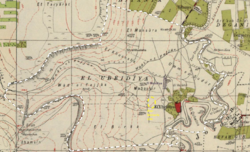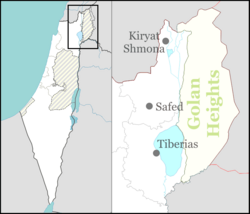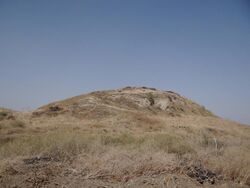Earth:Ubeidiya prehistoric site
| Alternative name | none |
|---|---|
| Location | Israel |
| Region | Jordan Valley, Jordan Rift Valley |
| History | |
| Periods | Pleistocene |
| Site notes | |
| Archaeologists | Moshe Stekelis, Georg Haas (paleontologist), Ofer Bar-Yosef, Naama Goren-Inbar; geologists Leo Picard and Nachman Shulman |
| Public access | Yes |
'Ubeidiya (Arabic: العبيدية; Hebrew: עובידיה), some 3 km south of the Sea of Galilee, in the Jordan Rift Valley, Israel, is an archaeological site of the early Pleistocene,[1] c. 1.5 million years ago, preserving traces of one of the earliest migrations of Homo erectus out of Africa, with (as of 2014) only the site of Dmanisi in Georgia being older.[2] The site yielded hand axes of the Acheulean type, but very few human remains.[3] The animal remains include a hippopotamus' femur bone, and an immensely large pair of horns belonging to a species of extinct bovid.
The site was discovered in 1959 and was first excavated between 1960 and 1974.
The site is distinct from nearby Tell Ubeidiya.
Etymology

The prehistoric site is named for the historical Palestinian village of Ubeidiya, which was centered on Tell 'Ubeidiya.
The name Ubeidiya comes from the Arabic word obeid, meaning "little slave", while a connection with the biblical name Obadiah cannot be ruled out.[4] Abeed is the Arabic word for slave.
Location
'Ubeidiya is located between the village Menahemia and Kibbutz Beit Zera, one kilometer northwest of the latter.
The prehistoric remains were found at a site distinct from the archaeological mound (tell) known as Tell 'Ubeidiya, some 400 metres northwest of the tell.
Excavation history
The prehistoric site was discovered in May 1959 near the tell, south of the Yavne'el stream (Wadi Fidjdjas), by a member of Kibbutz Afikim who was levelling the ground for agriculture with a bulldozer.[5] Excavations at the site began in 1960, led by Moshe Stekelis, assisted by zoologist Georg Haas, geologists Leo Picard and Nachman Shulman and several archaeology students, including Ofer Bar-Yosef and Naama Goren-Inbar. After Stekelis' death in 1967, Bar-Yosef and Goren-Inbar conducted the excavations.
Findings
Prehistoric remains starting from about 1.7 Mya (million years ago)[6][failed verification], more recently redated biochronologically to 1.5 Mya,[3] were discovered in the excavations, within about 60 layers of soil within which were found human bones and remains of ancient animals. These include some of the oldest remains found outside Africa, and more than 10,000 ancient stone tools[verification needed].
Today, the findings are preserved in the Israel Museum in Jerusalem.[7]
Human skeletal remains
In February 2022, archaeologists from the Israel Antiquities Authority, led by Professor Ella Been, announced the discovery of a 1.5-million-year-old complete hominin vertebra. According to the researchers, the fossilized bone belonging to a juvenile between the ages of 6-12 is the oldest evidence of ancient hominins in the Middle East. This latest discovery has shed new light on telling the story of prehistoric migration. The size and shape of the lower lumbar vertebra, dated to the Early Pleistocene, indicates that it belonged to an individual from a different species than the one represented by the 1.8-million-year-old skull unearthed at Dmanisi in the Republic of Georgia. After this discovery, Dr Barzilai assumed that different human species produced the stone tool industries present at Ubeidiya and Dmanisi, respectively.[8][9][10] The Ubeidiya child was an estimated 155 cm tall at death,[8] its predicted adult size being, in the conservative estimation of Prof. Ella Been, of more than 1.8 metres tall.[11] Regarding the species the hominin child belonged to, the authors of the paper published in the Scientific Reports journal are adopting there the cautious attitude of declaring it as "comparable to other early Pleistocene large-bodied hominins from Africa", but due to a lack of information about its morphology beyond what can be gleaned from a vertebra, they are declining to identify its species other than it being too large to belong to H. habilis.[8] In an interview with the Israeli newspaper Haaretz, however, Dr. Alon Barash, a palaeoanthropologist, quite categorically declares it to be a H. erectus.[11]
Other hominin skeletal material from Ubeidiya previously studied consists of a molar, a further minor finding, and a highly worn right lateral lower incisor.[3] The analysis of the more recently discovered incisor identified the hominin species to which it belongs as one of the three extant during the Lower Pleistocene, but could not securely distinguish to which of them: Homo habilis, H. ergaster, or H. erectus. The age of the deposits and the location within the Levantine corridor indirectly suggest it belonging to a H. ergaster hominin.[3]
UB 10749 was similar to the East African KNM WT 15000 of (Nariocotome III), KNM-ER 736 and KNM-ER 1808 from Koobi Fora and MK3 (IB7594) from Gombore in the Melka Kunture area (Ethiopia).[12]
Habitation remains and environment
The site also features rock surfaces in which the prehistoric man lived during the Pleistocene period. As a result of geologic breakage and foldage activity, the rock surfaces are now inclined at an angle of 70 degrees. It is thought that the area used to feature a pristine lake along which Homo erectus lived after his exodus from Africa. The finds discovered at the site validate this theory.[citation needed]
Nearby Tell 'Ubeidiya
Ruins of the Palestinian village of Ubeidiya, Tiberias, depopulated in 1948, are still visible on a nearby tell.
On the mound once[when?] stood a walled city which controlled the crossroads of the Jordan Valley and the road linking the Golan Heights to the port of Acco. Tell Ubeidiya is considered as one of the possible candidates for the Bronze Age city of Yenoam, known from Egyptian sources, but this is a matter of speculation.[13]
A 2012 trial excavation along the western fringes of the tell uncovered remains from the Early and Late Bronze, Iron, Persian, Roman, Byzantine, Early Islamic, Crusader, Mamluk and Ottoman periods.[14]
References
- ↑ Negev, Avraham; Gibson, Shimon (2001). Ubeidiya. New York and London: Continuum. p. 522. ISBN 0-8264-1316-1. https://books.google.com/books?id=l3JtAAAAMAAJ. Retrieved 25 July 2021.
- ↑ Sharon, Gonen (2014). "The Early Prehistory of Western and Central Asia". in Renfrew, Colin; Bahn, Paul. The Cambridge World Prehistory, Volume 3. Cambridge University Press. p. 1359. ISBN 9781139017831.
- ↑ 3.0 3.1 3.2 3.3 Belmaker, Miriam; Bar-Yosef, Ofer (July 2002). "New evidence for hominid presence in the Lower Pleistocene of the Southern Levant". Journal of Human Evolution 43 (1): 43–56. doi:10.1006/jhev.2002.0556. PMID 12098209. https://www.sciencedirect.com/science/article/abs/pii/S0047248402905567. Retrieved 31 July 2021.
- ↑ Claude Reignier Conder; Earl Horatio Herbert Kitchener Kitchener (1881). The Survey of Western Palestine: Arabic and English Name Lists Collected During the Survey. Committee of the Palestine Exploration Fund. pp. 121. https://books.google.com/books?id=ts84AQAAMAAJ&pg=PA121. "from 'Obeid, "a little slave" (but perhaps connected with the Biblical name Obadiah)."
- ↑ Stekelis, M., Prausnitz, M., Perrot, J., Kaplan, J., Department of Antiquities, Dothan, M., . . . Negev, A. (1960). NOTES AND NEWS. Israel Exploration Journal, 10(2), 118-128. Retrieved July 31, 2021, from http://www.jstor.org/stable/27924819
- ↑ Webb, Steve. The First Boat People 2006. page 8, citing Chernov 1987, Shipman 1992, Ganubia et al 1999.
- ↑ "Ubeidiya Collections". https://www.imj.org.il/en/place-collections/ubeidiya.
- ↑ 8.0 8.1 8.2 Barash, Alon; Belmaker, Miriam; Bastir, Markus; Soudack, Michalle; O'Brien, Haley D.; Woodward, Holly; Prendergast, Amy; Barzilai, Omry et al. (2022-02-02). "The earliest Pleistocene record of a large-bodied hominin from the Levant supports two out-of-Africa dispersal events". Scientific Reports (Nature Research) 12 (1): 1721. doi:10.1038/s41598-022-05712-y. ISSN 2045-2322. PMID 35110601.
- ↑ "1.5 million-year-old bone shines light on ancient human migration" (in en). 2022-02-02. https://www.independent.co.uk/world/discovery-bone-ancient-human-migration-b2006040.html.
- ↑ Tress, Luke. "Scientists find oldest evidence of humans in Israel — a 1.5 million-year-old bone". https://www.timesofisrael.com/scientists-find-oldest-evidence-of-humans-in-israel-a-1-5-million-year-old-bone/.
- ↑ 11.0 11.1 "Archaeologists Discover Missing Link in Human Evolution, in Israel". Ruth Schuster for Haaretz. 2 February 2022. https://www.haaretz.com/israel-news/archaeologists-discover-missing-link-in-human-evolution-in-israel-1.10584884.
- ↑ Alon Barash et al. The earliest Pleistocene record of a large-bodied hominin from the Levant supports two out-of-Africa dispersal events // Scientific Reports. Volume 12, Article number: 1721, 02 February 2022
- ↑ Na'aman, Nadav (1977-09-01). "Yeno'am". Tel Aviv 4 (3–4): 168. doi:10.1179/033443577788497687. ISSN 0334-4355. (Reprinted in Naʼaman, Nadav (2005). Canaan in the Second Millennium B.C.E.. Eisenbrauns. p. 195. ISBN 9781575061139.)
- ↑ Mokary, Abdalla (2014). "'Ubeidiya: Final Report (31/12/2014)". Hadashot Arkheologiyot (HA-ESI) (Israel Antiquities Authority (IAA)) 126. https://www.hadashot-esi.org.il/report_detail_eng.aspx?id=13703&mag_id=121. Retrieved 31 July 2021.
- Repenning, Charles A.; Fejfar, Oldrich (23 September 1982). "Evidence for earlier date of ′Ubeidiya, Israel, hominid site". Nature 299 (5881): 344–347. doi:10.1038/299344a0. https://www.nature.com/articles/299344a0. Retrieved 27 July 2021. (Free access only for abstract.)
- Horowitz, Aharon; Siedner, G.; Bar-Yosef, Ofer (16 March 1973). "Radiometric Dating of the Ubeidiya Formation, Jordan Valley, Israel". Nature 242 (5394): 186–187. doi:10.1038/242186a0. https://www.nature.com/articles/242186a0. Retrieved 27 July 2021. (Free access only for abstract.)
[ ⚑ ] 32°41′22″N 35°33′25″E / 32.68944°N 35.55694°E
 |




